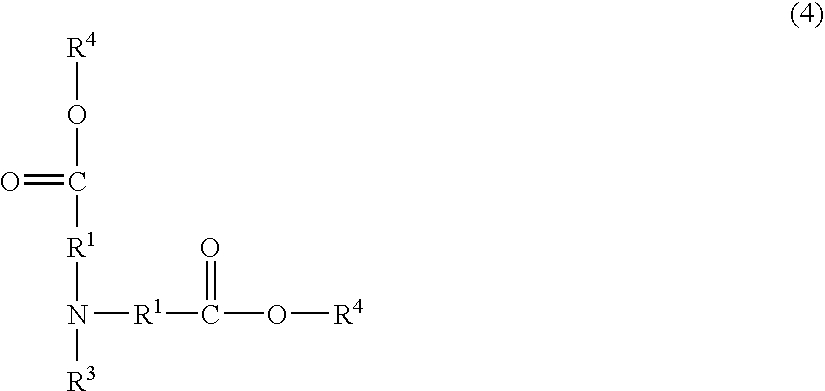Resist composition
a composition and resisting technology, applied in the field of resisting composition, can solve the problems of inability to control the reaction, insufficient effect, and inability to achieve good pka, and achieve the effects of excellent standing wave reducing effect, excellent rectangularity improving effect, and inferior sensitivity and resolution
- Summary
- Abstract
- Description
- Claims
- Application Information
AI Technical Summary
Benefits of technology
Problems solved by technology
Method used
Image
Examples
synthesis example 1
Synthesis of tris(2-formyloxyethyl)amine:
[0085] 12
[0086] A mixture of 6.00 g of triethanolamine and 200 g of formic acid was heated to 100.degree. C. for 20 hours. After removal of the formic acid by distillation under reduced pressure, the residue was diluted with ethyl acetate, followed by neutralization with a saturated aqueous solution of sodium bicarbonate. After separation into layers, washing with water and drying over anhydrous sodium sulfate, concentration was conducted under reduced pressure. The residue was purified by distillation under reduced pressure, whereby 8.10 g of tris(2-formyloxyethyl)amine was obtained (boiling point: 127 to 131.degree. C. / 60 Pa, yield: 86%).
[0087] IR (thin film): .nu.=2954, 2839, 1722, 1458, 1362, 1282, 1165, 1076, 1005 cm.sup.1. .sup.1H-NMR (300 MHz in CDCl.sub.3): .delta.=2.86(6H,t,J=5.9 Hz), 4.19(6H,t,J=5.9 Hz), 8.03(3H,s).
synthesis example 2
Synthesis of tris(2-acetoxyethyl)amine:
[0088] 13
[0089] In 150 g of THF was dissolved 14.9 g of triethanolamine. To the resulting solution was added 40.4 g of triethylamine. After cooling over an ice bath, 27.5 g of acetyl chloride was added dropwise at a temperature not exceeding 30.degree. C. The reaction mixture was heated to 75.degree. C. over an oil bath and heated for 2 hours to be refluxed. After completion of the maturation, the reaction mixture was allowed to cool down to room temperature. The reaction was terminated by the addition of 100 g of water. To the organic layer thus separated was added 200 g of dichloromethane. The organic layer was washed with 100 g of water. The organic layer was concentrated under reduced pressure, followed by distillation under reduced pressure, whereby 20.6 g of the title tris(2-acetoxyethyl)amine was obtained (boiling point: 145 to 148.degree. C. / 70 Pa, yield: 75%).
[0090] .sup.1H-NMR (300 MHz in CDCl.sub.3): .delta.=2.02(9H,s), 2.80(6H,t), 4...
synthesis example 3
Synthesis of tris(2-propionyloxyethyl)amine:
[0091] 14
[0092] In a similar manner to Synthesis Example 2 except for the use of propionyl chloride instead of acetyl chloride, tris(2-propionyloxyethyl)a-mine was synthesized (boiling point: 154 to 155.degree. C. / 30 Pa, yield: 82%).
[0093] .sup.1H-NMR (300 MHz in CDCl.sub.3): .delta.=1.09(9H,t), 2.29(6H,q), 2.80(6H,t), 4.08(6H,t).
PUM
 Login to View More
Login to View More Abstract
Description
Claims
Application Information
 Login to View More
Login to View More - R&D
- Intellectual Property
- Life Sciences
- Materials
- Tech Scout
- Unparalleled Data Quality
- Higher Quality Content
- 60% Fewer Hallucinations
Browse by: Latest US Patents, China's latest patents, Technical Efficacy Thesaurus, Application Domain, Technology Topic, Popular Technical Reports.
© 2025 PatSnap. All rights reserved.Legal|Privacy policy|Modern Slavery Act Transparency Statement|Sitemap|About US| Contact US: help@patsnap.com



